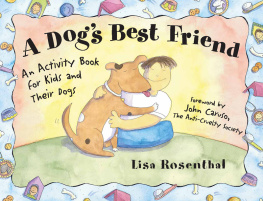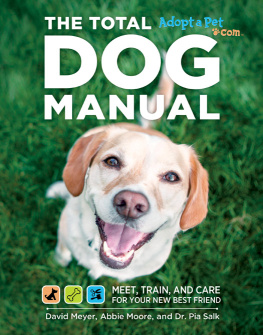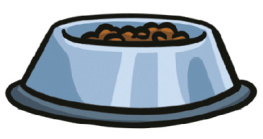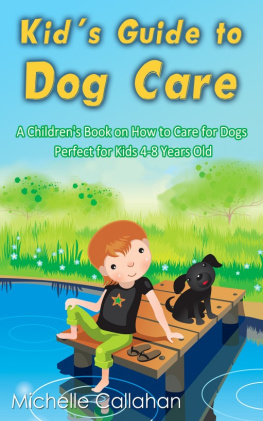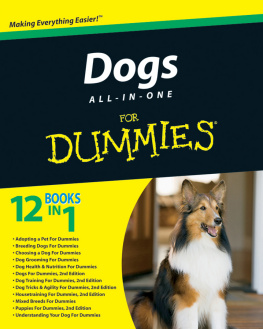

Library of Congress Cataloging-in-Publication Data
Rosenthal, Lisa, 1962
A dogs best friend : an activity book for kids and their dogs / Lisa Rosenthal
p. cm.
Includes bibliographical references (p. 162).
Summary: Over fifty activities and crafts and dozens of sidebars teach young children how to take care of their dogs while fostering a deep, long-lasting bond between child and dog.
ISBN 1-55652-362-9
1. Dogs Juvenile literature. 2. Creative activities and seat work Juvenile literature. [1. Dogs 2. Handicraft.] I. Title.
SF426.5.R665 1999 99-12455
636.70887dc21 CIP
1999 by Lisa Rosenthal
All rights reserved
Cover and interior illustrations: Bonnie Matthews
Cover and interior design: Mel Kupfer
The author and the publisher of this book disclaim all liability incurred in connection with the use of the information contained in this book.
Published by Chicago Review Press, Incorporated
814 North Franklin Street
Chicago, Illinois 60610
ISBN 1-55652-362-9
Printed in the United States of America
5 4 3 2 1
For Ted, the best partner
and playmate of all
Contents
Puppy love
Creature Comforts
Safety First
Nibbles & Treats
Play Time
Show & Tell Treats
Foreword
T he relationship a child forges with a companion dog can last a lifetime. The friendship, the sharing, the bond will stay with that child well into adulthood. When reminiscing, many people naturally dwell upon a special dog friend they had as children. They may be purebred or mixed. They may be big and galumphing or small and spritely. They may be lazy, hyper, furry, slobbery, silly, or majestic. But in the end, they are friends.
Often, a dog is the first exposure a child has to the wider world of responsibility. Lessons of duty and commitment frequently come in the guise of a canine companion. Dogs depend upon people for all of the things they need to lead happy, healthy lives, and children can play an important part in their care.
A Dogs Best Friend is a wonderful guidebook to help children develop a friendship with their dogs through participation and understanding. The activities laid out in this book have been designed to maximize childrens interactions with their pets. Some activities emphasize direct involvement, such as administering proper feeding or recognizing when vet care is required. Others, though, develop intangibleyet equally importantaspects of friendship such as sharing and discovery, with ideas ranging from creating appropriate gifts for a dog to learning about the history of dogs.
These activities are safe (when all directions are followed and under adult supervision) and will help to promote a deep, caring bond between children and their dogs. Such a bond is invaluable not only to the specific relationship between child and pet, but also to the development of the childs awareness of the needs of others, human and nonhuman alike. Compassion, caring, and kindness become happy accidents upon the path to friendship.
Take a moment. Peruse the book. See the many ways in which a child can enhance his or her understanding of a pet. Participate in the activities with a child. Then, see that child develop a friendship and memories that will last a lifetime.
John Caruso, director of humane education, The Anti-Cruelty Society
Introduction for Parents
K ids and dogs is a great mix! Having a pet puppy or dog provides a regular source of fun and exercise for your kidswithout carpooling and with no assembly or batteries required! Caring for an animal can teach kids many valuable lessons including
- Responsibility from taking care of the animal,
- Patience from training and playing games with the animal,
- Confidence from teaching the animal tricks,
- Leadership from remembering to provide for the dogs needs, and
- Satisfaction from a job well done.
Kids will have fun and at the same time develop a positive self-image.
A Dogs Best Friend is written with the belief that regular healthy interaction between a kid and her dog will lead to good care for the animal while teaching valuable life lessons. Activities are designed to keep kids involved with their four-legged pals after the initial excitement is over. Your kid will find fun games to play with his dog and cool things to make for his four-legged friend. Most of the activities require only household items and a little imagination; many can be done individually. Adult help is suggested for those activities that require the use of the oven or tools.
Good pet-care tips and information, collected from pet-care professionals and extensive research, are included as well. Appendix 1 provides a valuable childrens reading list provided by The Anti-Cruelty Society. Youll find books about dogs, cats, owls, and other animals that will teach kids about caring for their new four-legged friend, help them to deal with the loss of a pet, offer great adventure tales, and more. Appendix 2 is a resource section that provides the addresses of animal-friendly Web sites, cable stations, and organizations that can provide you with more information or additional fun animal time.


Healthy Hound Hint
Many pet-care professionals suggest that you keep your dog indoors and make him part of your family.
Checklist of Considerations Before Bringing a Dog Home
A dog is a constant, loyal, unconditional friend for your child. However, there are a number of important things to consider before bringing a dog into your household.
- Think about your lifestyle, your family, and your finances. Any animal that you adopt will require a long-term commitment from you and everyone else in the household. Its a commitment that should last for your dogs lifetime.
- Talk with everyone in your home before adopting a pet. This is the time when youre likely to find out who your pet-care helpers will be and who wont be helping.
- How many hours a day is your house empty? Puppies can be adopted as young as seven or eight weeks old, but such young creatures need to develop self-confidence so that they will interact in healthy ways with kids and other household members. This confidence is built by not leaving the puppy alone for long periods of time and giving him a lot of attention and even a few short obedience training sessions where your puppy can receive much-needed praise. Training problems (such as chewing on things you dont want him to) may develop if the dog is left home alone too often.
- Is an adult in the household willing to provide the obedience trainingincluding socializing, behavioral training, and house trainingto make the addition of a puppy to your home a good choice?
- What kind of time do you have available for a dog? Are you home a lot but work out of your home so that youre not readily available?
Next page
